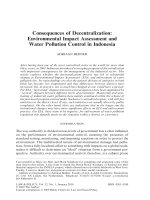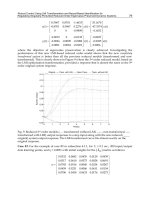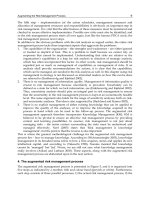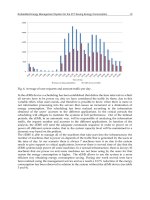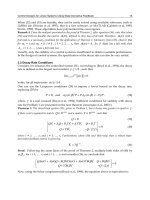Herbicides Environmental Impact Studies and Management Approaches Part 2 ppt
Bạn đang xem bản rút gọn của tài liệu. Xem và tải ngay bản đầy đủ của tài liệu tại đây (4.93 MB, 20 trang )
Evaluation of Toxicities of Herbicides
Using Short-Term Chronic Tests of Alga, Daphnid and Fish
9
2009
MEC (g/L)
A B C D E F G
Dimethametryn 0.65 0.71 0.64 3.33 0.11 0.17 0.17
Pretilachlor 0.40 0.56 0.13 1.66 5.98 - 3.23
Bromobutide 7.78 0.94 2.99 38.60 7.27 5.28 81.40
Carbetamide 0.85 - - 1.35 - - 3.56
Bendiocarb 0.16 - 0.26 5.68 - - -
Triazine - - - - - - -
Cyanazine - - - - - - -
Simetryn - - - - - - -
Esprocarb 0.27 0.32 - - 0.11 - 1.85
Mefenacet 0.92 - 1.89 - 1.32 0.21 0.65
-;not detected in the field.
(a)
2010
MEC (g/L)
H I J K L M N
N
(30d
after )
Dimetha
-metryn
0.05 0.04 0.13 0.03 - - 0.03 -
Pretilachlor - - - - - - - -
Bromobutide 0.35 0.55 47.29 54.84 0.54 0.18 53.88 0.13
Carbetamide - - 0.83 1.66 - - 1.64 -
Bendiocarb - - - - - - - -
Triazine - - - - - - - -
Cyanazine - - - - - - - -
Simetryn 0.27 0.17 - - - - - -
Esprocarb - - - - - - - -
Mefenacet - - - - - - 0.03 -
-;not detected in the field.
(b)
Table 3. Actual concentrations of herbicides in the water samples by the simultaneous
analysis (MEC; Measured Environmental Concentrations) in 2009 (a) and 2010 (b).
Herbicides – Environmental Impact Studies and Management Approaches
10
Fig. 3. Actual concentrations of herbicides in each sampling spot.
3.4 The risk evaluation of each spot based on the field measurements
Applying ecological toxicity data of 10 herbicides, a risk evaluation based on the MEC of
each spot was performed. MEC/NOEC was calculated with the species that showed lowest
NOEC for each target substance used in the present study (shown in Table 4 and Fig 4).
When the MEC/NOEC ratios of each herbicide are simply tallied, the total sums exceeded 1
in three spots (D, E and G). Yet from the results of Table 1, ecological effects at nine spots, A,
B, C, D, E, F, G, L and N, are reported to be present. From the results of Table 4, at least at
spots D, E, and G the ecological effect of the pesticide, which was measured in this study, is
suspected to be present. Because Σ (MEC/NOEC) measured in this exposure was less than 1
in eleven spots of A, B, C, F, H, I, J, K, L, M and N, it is suggested that the observed effect
may be attributed to a wholly different chemical substance, perhaps a herbicide that is
unaccounted for in Table 4, or a non-pesticide chemical.
30d after dispersal
0
10
20
30
40
50
60
70
80
90
100
ABCDEFGHI JKLMNN
MEC(μg/L)
sites
Mefenacet
Esprocarb
Simetryn
Cyanazine
Triazine
Bendiocarb
Carbetamide
Bromobutide
Pretilachlor
Dimethametryn
Evaluation of Toxicities of Herbicides
Using Short-Term Chronic Tests of Alga, Daphnid and Fish
11
2009 MEC/NOEC
A B C D E F G
Dimetha
-metryn
0.129 0.143 0.128 0.666 0.023 0.034 0.034
Pretilachlor 0.398 0.558 0.133 1.660 5.980 - 3.230
Bromobutide 0.008 0.001 0.003 0.039 0.007 0.005 0.081
Carbetamide 0.014 - - 0.022 - - 0.057
Bendiocarb 0.025 - 0.042 0.902 - - -
Triazine - - - - - - -
Cyanazine - - - - - - -
Simetryn - - - - - - -
Esprocarb 0.010 0.013 - - 0.004 - 0.066
Mefenacet 0.036 - 0.073 - 0.051 0.008 0.025
∑(MEC/NOEC)
0.619 0.714 0.378 3.288 6.065 0.047 3.493
(a)
2010 MEC/NOEC
H I J K L M N
N (30d
after )
Dimetha
-metryn
0.01 0.008 0.026 0.006 - - 0.006 -
Pretilachlor - - - - - - - -
Bromobutide 0.0004 0.0006 0.0473 0.0548 0.0005 0.0002 0.0539 0.0001
Carbetamide - - 0.013 0.027 - - 0.026 -
Bendiocarb - - - - - - - -
Triazine - - - - - - - -
Cyanazine - - - - - - - -
Simetryn 0.075 0.047 - - - - - -
Esprocarb - - - - - - - -
Mefenacet - - - - - - 0.001 -
∑
(MEC/NOEC)
0.085 0.056 0.087 0.087 0.001 0.0002 0.087 0.0001
(b)
Table 4. A risk evaluation based on the measurement value (MEC/NOEC) in 2009 (a) and
2010 (b).
Herbicides – Environmental Impact Studies and Management Approaches
12
Fig. 4. Σ (MEC/ NOEC) of each sampling spot.
Three aquatic species were used for toxicity tests using dimethametryn, pretilachlor,
cyanazine and simetryn, all of which showed growth inhibition of alga even at
concentrations lower than 10 μg/L. The aquatic species most strongly affected by these
herbicides was the alga in the present study. Separately, in bendiocarb the highest toxicity
was encountered in the crustacean, decreasing the number of offspring at 12.5 μg/L and
was 10 times more sensitive compared to alga. Daphnia had the highest sensitivity to
bendiocarb. In summary, 100-1000 times differences in toxicity of various herbicides were
encountered. The fish were far less sensitive to toxicity of herbicides than alga, similarly or
less sensitive than daphnid in this test. Though fish were shown to be less sensitive, the
pesticide dispersion period in Japanese farm occurs during same time as spawning and/or
hatching period in wildlife. Therefore, accumulation of toxicity data including fish is needed
to perform a more detailed evaluation of ecological risk of herbicides. In addition,
accumulation of chronic data of herbicides using the aquatic species is also needed to
protect wildlife and the ecosystem.
4. A green alga and a blue-green alga
Relying solely upon green alga for risk evaluation and analysis of herbicide effect is not only
insufficient for proper analysis, but may also lead to bias and error. For example, the effect
of a chemical substance on germination and rooting cannot be evaluated because the green
alga is a unicellular organism. Furthermore, different toxicity for various organism species
30d after dispersal
0
1
2
3
4
5
6
7
ABCDE FGH I J K LMNN'
Σ (MEC/NOEC)
sites
Mefenacet
Esprocarb
Simetryn
Cyanazine
Triazine
Bendiocarb
Carbetamide
Bromobutide
Pretilachlor
Dimethametryn
Evaluation of Toxicities of Herbicides
Using Short-Term Chronic Tests of Alga, Daphnid and Fish
13
has been reported in some herbicides (Suárez-Serrano et al., 2010; Roubeix et al., 2011;
Pereira et al., 2009). In other words, a herbicide may have a selective property; imposing no
effect on growth of agricultural crops, yet able to effectively inhibit weeds growth e.g., the
ineffective to rice and effective to wild millet. Lemna sp. Growth Inhibition Test (OECD
TG221, 2006) can be used in addition to green alga toxicity test; however, herbicides toxicity
data using duckweed are limited at present.
Blue-green alga (Synechococcus leopoliensis) has been used as a test species in addition to the
green alga (P. subcapitata), and compared for herbicide toxicity. Because the blue-green alga
is also a single cell organism, it can only serve as a biological reference to show species
specific difference (Kaur et al., 2002; Vaishampayan et al., 1984; Lehmann-Kirk et al., 1979).
Differences in toxicity effect between the green alga and blue-green alga using eight kinds of
pesticides are shown in Figure 5.
Fig. 5. Comparison of herbicide toxicity using green alga and blue-green alga.
Correlation of herbicide toxicity was hardly shown between green alga and blue-green alga
(Fig. 3). However, the green alga and blue-green alga displayed approximately similar
sensitivity to simetryn, cyanazin, and cyromazine. The green alga showed susceptible
sensitivity in the toxicity other than dimethametryn. The green alga has been commonly
used for ecological risk evaluation of chemicals including herbicides; however, it is also
necessary to accumulate the test data using multicellular plants such as floating weeds in
the future.
5. Conclusions
Fate of herbicides after their release into the environment is extremely difficult to grasp
precisely. Regarding the adverse effects of herbicides on the environment (water, soil and
mefenacet
cyanazin
simetryn
esprocarb
dimethametryn
pretilachlor
cafenstrole cyromazine
0.1
1
10
100
1000
10000
100000
0.1 1 10 100 1000 10000 100000
Blue-Green alga
(NOEC,μg/L)
Green alga (NOEC,μg/L)
Herbicides – Environmental Impact Studies and Management Approaches
14
air contamination from leaching, runoff, and spray drift, as well as the detrimental effects on
wildlife, fish, plants, and other non-target organisms), the well being of resulting
environmental state depends on the toxicity of the herbicides themselves(Monaco et al.,
2002; Eleftherihorinos, 2008). Detailed information will be needed concerning measurements
of exposure levels of herbicides during their application, the dosage applied, the adsorption
on soil colloids, the weather conditions prevailing after application, and pesticide
persistence in the environment.
As for the risk assessment of the impact of herbicides on the environment, a simple and
precise process does not exist (Commission of the European Communities, 1991; EPA,
2009; FAO, 2002; Abrantes et al., 2009). Various examples point to multivariate
ecological effect based on various environments, and the ecological risk changes on a
case-by-case basis. Hence, we need to instead depend upon data gained through
exposure periods and exposure levels, toxicity and the durability of applied herbicides,
as well as taking in account the local environmental characteristics for proper risk
evaluation of herbicides.
It has been recognized, however, that an impact on the environment of herbicides included
in the agriculture drainage could be estimated to some extent by performing short-term
chronic toxicity tests (Cantelli-Forti et al., 1993). The ecological toxicity tests may detect the
effect of not only herbicides but also the chemical substances used for daily life and sewage
effluents. For consideration of environmental risk of chemicals in general, synergistic effects
with herbicides and other substances should be detected. The monitoring of the
environmental water using the aquatic species will become an important index for the
chemical safety and control of environmental chemicals including herbicides.
6. Acknowledgments
Part of the data used here was carried out as a government-funded research sponsored by
the Agricultural Chemicals Control Office of the Ministry of the Environment. We thank Dr.
Tapas Chakraborty, National Institute for Basic Biology, Japan for his critical reading of this
manuscript.
7. References
Abrantes N, Pereira R, de Figueiredo DR, Marques CR, Pereira MJ, Gonçalves F. (2009). A
whole sample toxicity assessment to evaluate the sub-lethal toxicity of water and
sediment elutriates from a lake exposed to diffuse pollution. Environ Toxicol. 24(3):
259-70.
Akiyama Y, Yoshioka N, Ichihashi K. (2005). Study of pesticide residues in agricultural
products for the "Positive List" system. Shokuhin Eiseigaku Zasshi 46(6): 305-18.
Añasco N, Uno S, Koyama J, Matsuoka T, Kuwahara N. (2010). Assessment of pesticide
residues in freshwater areas affected by rice paddy effluents in Southern Japan.
Environ Monit Assess. 160(1-4): 371-83.
Cantelli-Forti G, Paolini M, Hrelia P. (1993). Multiple end point procedure to evaluate risk
from pesticides. Environ Health Perspect. 101(Suppl 3): 15–20.
Evaluation of Toxicities of Herbicides
Using Short-Term Chronic Tests of Alga, Daphnid and Fish
15
Commission of the European Communities. (1991). Council Directive 91/414/EEC of 15 July
1991 Concerning the Placing of Plant Protection Products on the Market; Official
Journal L 230; Commission of the European Communities: Brussels, Belgium.
Cooper, J.; Dobson, Η. (2007). The benefits of pesticides to mankind and the environment.
Crop Prot., 26: 1337-1348.
Damalas, C.A. (2009). Understanding benefits and risks of pesticide use. Sci. Res. Essays, 4:
945-949.
Eleftherohorinos, I.G. Weed Science. (2008). Weeds, Herbicides, Environment, and Methods
for Weed Management; AgroTypos: Athens, Greece.
Environment Canada (2007). Biological Test Method: Test of Reproduction and Survival
Using the Cladoceran Ceriodaphnia dubia. 74pp.
EPA. Registering Pesticides (2009). Available online:
re-gistering/index.htm (accessed on
1 Sep. 2011).
EPA Biological Test Method (2007): Test of Reproduction and Survival Using the Cladoceran
('Ceriodaphnia dubia') EPS1/RM/21, />9791-487E-81DB-E784433B2419/21 NO-HL.pdf (accessed on 1 Sep. 2011).
FAO. (2002). Manual on the Submission and Evaluation of Pesticide Residues Data for the
Estimation of Maximum Residue Levels in Food and Feed; Food and Agriculture
Organization: Rome, Italy.
Hirahara Y. (2007). Status of inspection of imported foods after introduction of the positive
list system for agricultural chemical residues in foods mainly about analysis of
pesticide residue in foods. Shokuhin Eiseigaku Zasshi. 48(4): J299-302.
Japan Plant Protection Association. (2010). Annual Inventory of Registered Pesticides and
Their Use (in Japanese).
Kadokami K, Tanada K, Taneda K, Nakagawa K. (2005). Novel gas chromatography-mass
spectrometry database for automatic identification and quantification of
micropollutants. J Chromatogr A. 1089 (1-2): 219-226.
Kang HS, Park CJ, Gye MC. (2009). Effects of molinate on survival and development of
Bombina orientalis (Boulenger) embryos. Bull Environ Contam Toxicol. 82(3): 305-
309.
Kim Y, Jung J, Oh S, Choi K. (2008). Aquatic toxicity of cartap and cypermethrin to different
life stages of Daphnia magna and Oryzias latipes. J Environ Sci Health B. 43(1): 56-64.
Lehmann-Kirk U, Bader KP, Schmid GH, Radunz A. (1979). Inhibition of photosynthetic
electron transport in tobacco chloroplasts and thylakoids of the blue green alga
Oscillatoria chalybea by an antiserum to synthetic zeaxanthin. Z Naturforsch C.
34(12): 1218-1221.
Maitani T. (2005). Introduction of the "Positive List" system for agricultural chemicals in
foods and development of analytical methods recent amendment of regulation on
pesticides by the Ministry of Health, Labour and Welfare, the Ministry of
Agriculture, Forestry and Fisheries, and the Ministry of the Environment. Shokuhin
Eiseigaku Zasshi. 46(6): J327-334.
Maitani T. (2007). Notification of the "positive list system for agricultural chemicals in foods"
and subsequent management. Shokuhin Eiseigaku Zasshi. 48(6): J402-410.
Herbicides – Environmental Impact Studies and Management Approaches
16
Marques CR, Pereira R, Antunes SC, Cachada A, Duarte AC, Gonçalves F. (2011). In situ
aquatic bioassessment of pesticides applied on rice fields using a microalga and
daphnids. Sci Total Environ. 409(18) : 3375-3385.
Matthews, G.A. (2006). Pesticides: Health, Safety and the Environment; Blackwell Publishing:
Oxford, UK.
Ministry of Agriculture, Forestry and Fisheries. (2006). The Census of Agriculture and
Forestry 2005.
Ministry of Agriculture, Forestry and Fisheries. (2011). The Census of Agriculture and
Forestry 2010.,
(accessed on 1 Sep. 2011).
Ministry of Agriculture, Forestry and Fisheries. (2010). Statistics about the GDP (gross
domestic product), (accessed
on 1 Sep. 2011).
Ministry of the Environment. (2006). Actual situation research report for the aquatic effect of
the pesticide, (an independent administrative agency National Institute for
Environmental Studies version) (in Japanese).
Ministry of the Environment. (2007). Actual situation research report for the aquatic effect of
the pesticide, (an independent administrative agency National Institute for
Environmental Studies version. (in Japanese).
Ministry of the Environment. (2008). Actual situation research report for the aquatic effect of
the pesticide, (an independent administrative agency National Institute for
Environmental Studies version). (in Japanese).
Ministry of the Environment. (2009). Actual situation research report for the aquatic effect of
the pesticide, (an independent administrative agency National Institute for
Environmental Studies version). (in Japanese).
Ministry of the Environment. (2010). Actual situation research report for the aquatic effect of
the pesticide, (an independent administrative agency National Institute for
Environmental Studies version). (in Japanese).
Miyashita S, Shimoya M, Kamidate Y, Kuroiwa T, Shikino O, Fujiwara S, Francesconi KA,
Kaise T. (2009). Rapid determination of arsenic species in freshwater organisms
from the arsenic-rich Hayakawa River in Japan using HPLC-ICP-MS. Chemosphere
75(8): 1065-1073.
Monaco, J.T.; Weller, S.C.; Ashton, F.M. (2002). Herbicide registration and environmental
impact. In Weed Science: Principles and Practices, 4th ed.; Monaco, T.J., Weller,
S.C., Ashton, F.M., Eds.; John Wiley & Sons: New York, NY, USA.
Nagayama T. (2010). Regulation of the pesticide residues in foods and the positive list
system. Shokuhin Eiseigaku Zasshi 51(6): 340-348.
Nakano Y, Miyazaki A, Yoshida T, Ono K, Inoue T., (2004). A study on pesticide runoff from
paddy fields to a river in rural region 1: field survey of pesticide runoff in the
Kozakura River, Japan. Water Res. 38(13): 3017-3022.
Numabe A, Nagahora S. (2006). Estimation of pesticide runoff from paddy fields to rural
rivers. Water Sci Technol. 53(2): 139-146.
Evaluation of Toxicities of Herbicides
Using Short-Term Chronic Tests of Alga, Daphnid and Fish
17
OECD Environmental Performance Reviews: Japan (2002). Organisation for Economic Co-
Operation and Development, Organization for Economic (2002/05).
OECD TG 201, (2002), OECD Guideline No. 201. (2002). Freshwater Alga and Cyanobacteria,
Growth Inhibition Test, OECD Guidelines
(accessed on 1 Sep. 2011).
OECD TG 221, (2006). OECD Guideline No. 221. (2006). OECD Lemna sp. Growth Inhibition
Test.
Oerke, E.C.; Dehne, H.W. (2004). Safeguarding production-losses in major crops and the role
of crop protection. Crop Prot. 23: 275-285.
Pereira JL, Antunes SC, Castro BB, Marques CR, Gonçalves AM, Gonçalves F, Pereira R.
(2009). Toxicity evaluation of three pesticides on non-target aquatic and soil
organisms: commercial formulation versus active ingredient. Ecotoxicology18(4):
455-463.
Roubeix V, Mazzella N, Schouler L, Fauvelle V, Morin S, Coste M, Delmas F, Margoum C.
(2011). Variations of periphytic diatom sensitivity to the herbicide diuron and
relation to species distribution in a contamination gradient: implications for
biomonitoring. J Environ Monit. 13(6): 1768-1774.
Saito I . (2007). The viewpoint and approach for regulation of Japanese positive list system
for agricultural chemical residues in foods as one cooperative federation. Shokuhin
Eiseigaku Zasshi 48(4): J291-295.
Sakai M. (2002). Use of chronic tests with Daphnia magna for examination of diluted river
water. Ecotoxicol Environ Saf. 53(3): 376-381.
Suárez-Serrano A, Ibáñez C, Lacorte S, Barata C. (2010). Ecotoxicological effects of rice field
waters on selected planktonic species: comparison between conventional and
organic farming. Ecotoxicology 19(8): 1523-1535.
Sudo M, Kunimatsu T, Okubo T. (2002). Concentration and loading of pesticide residues in
Lake Biwa basin (Japan). Water Res., 36(1): 315-329.
Tanabe A, Mitobe H, Kawata K, Yasuhara A, Shibamoto T. (2001). Seasonal and spatial
studies on pesticide residues in surface waters of the Shinano river in Japan. J Agric
Food Chem. 49(8): 3847-3852.
Tsuda T, Igawa T, Tanaka K, Hirota D. (2011). Changes of concentrations, shipment
amounts and ecological risk of pesticides in river water flowing into lake Biwa. Bull
Environ Contam Toxicol., 87(3): 307-311.
Vaishampayan A. (1984). Powerful mutagenicity of a bipyridylium herbicide in a nitrogen-
fixing blue-green alga Nostoc muscorum. Mutat Res., 138(1): 39-46.
Vu SH, Ishihara S, Watanabe H. (2006). Exposure risk assessment and evaluation of the best
management practice for controlling pesticide runoff from paddy fields. Part 1:
Paddy watershed monitoring. Pest Manag Sci. 62(12): 1193-1206.
Wei D, Lin Z, Kameya T, Urano K, Du Y. (2008). Application of biological safety index in
two Japanese watersheds using a bioassay battery. Chemosphere 72(9): 1303-
1308.
Wilson, C.; Tisdell, C. (2001). Why farmers continue to use pesticides despite environmental,
health and sustainability costs. Ecol. Econ. 39: 449-462.
Herbicides – Environmental Impact Studies and Management Approaches
18
WHO (2010). International Code of Conduct on the Distribution and Use of Pesticides:
Guidelines for the Registration of Pesticides; World Health Organization: Rome,
Italy.
2
Herbicide Phytotoxicity and Resistance to
Herbicides in Legume Plants
Agnieszka I. Piotrowicz-Cieślak
1
and Barbara Adomas
2
1
Department of Plant Physiology and Biotechnology,
2
Department of Air Protection and Environmental Toxicology,
University of Warmia and Mazury in Olsztyn
Poland
1. Introduction
Active substances in herbicides, just like in other pesticides, are chemical compounds
synthesized in order to kill organisms which are harmful for cultivated plants. Therefore,
they are toxins introduced on purpose by man into the environment. From the perspective
of environmental protection, it is very significant that herbicides are most often applied
directly into the soil to manage weeds. Since DDT and chloro-organic herbicides such as
2,4,5-T were withdrawn (in the 1970s) and since the EU regulations were unified for all its
member countries, plant protection techniques have advanced considerably. Yet, pesticides,
thus herbicides as well, continue to be a big group of xenobiotics periodically occurring at
high levels in agroecosystems. These compounds infiltrate into related biocenoses from air,
soil, water and food (Allinson & Morita, 1995; Kolpin et al., 1998; Adomas at al., 2008). Soil
may become a reservoir of various pollutants, including herbicides. Herbicides remain
active in soil for different periods. Paraquat has a relatively long half-life in soil (estimated
at about 1000 days). The half-life of glyphosate in soil is only 10 to 100 days, and according
to Monsanto the average half-life of this herbicide is 32 days (Hornsby et al., 1996;
Monsanto, 2005). Remainders of persistent herbicides (e.g. atrazine, metribusin, and
trifluralin) can stay in soil and destroy subsequent plantations a year or more after
herbicides had been used. Herbicides from soil leach into surface water and ground water.
The assessment of herbicides content in the aquifers in Iowa shows that 75% of herbicides
(Kolpin et al., 1998), despite degradation, are still detected. From soil, water or air,
herbicides get into crops (Adomas et al., 2008). When pesticides are applied, acceptable
remainders of active substances (MRL) can often be detected in cultivated plants.
Depending on physicochemical properties of the active substances of pesticides and the
ways of their detoxification, some of these pollutants tend to increase concentration while
passing through organisms of higher trophic levels. It can lead to a significant
bioaccumulation of toxins in the food chains (Allinson & Morita, 1995; Dinis-Oliveira et al.,
2006). No doubt therefore, monitoring of herbicide (including desiccant) residues in
cultivated plants is needed, so that people and environment can be safe. Moreover,
application of herbicide desiccants modifies physiological properties of seeds and may thus
lead to delayed problems, becoming evident long after the treatment.
Herbicides – Environmental Impact Studies and Management Approaches
20
2. Physiological changes after preharvest desiccation of plants
Preharvest application of herbicides (desiccants, e.g. glufosinate ammonium (Basta 200 SL)
or diquat (Reglone Turbo 200 SL)), is aimed at removing excessive water from plant cells
and balancing maturation. Dehydration is best tolerated by plant reproductive organs/cells:
seeds, pollens, spores, aestive buds and somatic embryos. In the developmental cycle, the
majority of seeds go through the stage of natural, physiological drying, yet not all the seeds
dry. Based on their tolerance to desiccation, seeds have been divided into three groups:
orthodox (which can be chemically desiccated, Fig. 1), recalcitrant and intermediate
(Piotrowicz-Cieślak et al., 2007). Orthodox seeds tolerate dehydration relatively well and
may retain their viability for a long time (Murthy et al., 2003).
Fig. 1. Basic stages of seed ontogenesis and dry mass accumulation in yellow lupin seeds.
Chemical desiccation is carried out during natural dehydration of seeds.
They are resistant to water loss below 5% of the initial water content. During desiccation,
orthodox seeds can lose over 90% of water, and as a result slow down their metabolism and
become dormant (Adams & Rinne, 1980). Seeds of this type are produced by most monocots
and dicots of the temperate climate zone (Walters & Towill, 2004). Seed desiccation is a
prerequisite for completion of their life cycle and it can be chemically forced. Recalcitrant
seeds perish as a result of drying below a critical level of water, which is usually quite high
and amounts to 40% (Roberts, 1973). Desiccation cannot be applied in this group of plants
which includes tropical trees, e.g. avocado, mango, litchi, cocoa (Farrant et al., 1993) and
some grasses (Probert & Longley, 1989). The third group – i.e. intermediate (suborthodox)
seeds are tolerant to dehydration if it stops at seed water level 6-10% (Ellis et al., 1991). It
Herbicide Phytotoxicity and Resistance to Herbicides in Legume Plants
21
seems that chemical desiccation can be successfully applied in this group, however mild
(with small dessicant doses). Moreover, intermediate seeds do not tolerate cold while being
dehydrated (Hong & Ellis, 1996). Chemical desiccation of plants is performed during the
period when orthodox seeds start their natural drying. Yet, precise determination of this
period depends on the species, the pace of water loss and its expected final content. Many
processes contribute to preservation of seed vigour and viability during both natural and
accelerated (chemical) drying.
2.1 Biochemical changes in seeds resulting from desiccant application
The rate of water loss during seed desiccation has a profound effect on seed condition at
cellular and subcellular levels. Organelles in the cytoplasm become compacted together,
cytoplasm viscosity increases and a number of degenerative reactions intensify. In order
for the cell to protect itself against dehydration, it has to accumulate protective
compounds. A wide group of such substances was detected in seeds, for example proline,
glutamine, fructans, poliols, trehalose, carnitine and others. A lot of plants respond to
desiccation caused dehydration by accumulating so-called ‘compatible solvents’ (i.e.
molecules not interfering with the structure and functions of the cell), including one kind
or more of the above given substances. Unfortunately, concentration of these hydrophilic
compounds is often not sufficient to bind water properly (Hare et al., 1998). Yet, probably
it is one of the most important mechanisms protecting macromolecules under conditions
of limited water loss. Molecules of compatible compounds form a protective layer around
proteins, thus preventing protein deformations (Crowe et al., 1990). During desiccation,
changes occur at all levels of plant cell functions. Maintaining the integrity of genetic
material and keeping the DNA repair mechanisms functional during dehydration are the
most important for seed survival. As a result of water loss during seeds desiccation the
genetic material undergoes conformational changes, depending on its nucleotide
sequence and interactions with specific DNA-binding proteins (Osborne & Boubriak,
1994). A higher stability of seed DNA structure probably indicates increased seed
tolerance to desiccation. At the early stages of seed ontogenesis, desiccation leads to
frequent chemical modifications of DNA bases, resulting in a modified DNA methylation
level. The later chemical desiccation is applied in the ontogenetic development of seeds,
the fewer epigenetic changes are thus caused.
2.1.1 Soluble carbohydrates and their derivatives content in seeds
Yellow lupin plants (Lupinus luteus L. cv. Taper and Mister) were grown in 10-L pots in
greenhouse (Fig. 2) with a 12-h photoperiod at 20
o
C day/18
o
C night and 140 µmoles
photons m
-2
s
-1
irradiace. Mixture of peat, garden soil and sand (1:1:1, v:v:v) was used as
substrate for plant growth. On the day of flowering the plants were labelled and divided
into three groups: a control and two treatments. Basta 200 SL (producer Bayer Poland, active
substance (a.i.) glufosinate ammonium) was applied in the amount of 4,1 µg a.i. per pot (the
preparation was diluted in 15 ml of distilled water). Roundup Ultra 360 SL (producer
Monsanto Poland, a.i. glyphosate) was applied in the amount of 4,1 µg a.i. per pot (here the
preparation was diluted in 15 ml of distilled water too). Herbicide levels applied in this
experiment corresponded to the field doses 2.5 and 3 L/ha, respectively.
Herbicides – Environmental Impact Studies and Management Approaches
22
Fig. 2. Lupin plants and seeds during and two weeks after desiccation treatment.
Seeds were collected in five-day intervals, starting from 15 days after flowering (DAF) until
full physiological seeds maturity. Soluble carbohydrates content in seeds were analysed by
GC chromatography according to Piotrowicz-Cieślak (2005). Seeds (30 – 60 mg fresh mass)
were homogenised in ethanol: water, 1:1 (v/v) containing 300 μg phenyl-α-D-glucose as
internal standard. The homogenate and the wash were combined in a 1.5 ml microfuge tube,
heated at 75C for 30 min to inactivate endogenous enzymes and centrifuged at 15 000 g for
20 min. The supernatant was passed through a 10 000 MW cut-off filter (Lida, Kenosha, WI
USA). Aliquots of 0.3 ml filtrate were transferred to silylation vials and evaporated to
dryness (Eppendorf Concentrator 5301). Dry residues were derived with 300 μl of silylation
mixture (trimethylsilylimidazole : pyridine, 1:1, v/v) in silylation vials (Thermo Scientific) at
70C for 30 min, and then cooled at room temperature. One μl carbohydrate extract was
injected into a split-mode injector of a Thermo Scientific gas chromatograph equipped with
flame ionisation detector. Soluble carbohydrates were analysed on a DB-1 capillary column
(15 m length, 0.25 mm ID, 0.25 μm film thickness, J&W Scientific). Soluble carbohydrates
were identified with internal standards as available, and concentrations were calculated
from the ratios of peak area, for each analysed carbohydrate, to the peak area of respective
internal standard. Quantities of soluble carbohydrates were expressed as mean ± SD for 3-5
replications of each treatment.
2.1.2 The role and content of soluble carbohydrates in seed drying
The composition of carbohydrates, with particular regard to content of raffinose family
oligosaccharides, has been measured in seeds of many species. Raffinose content exceeds 1
% d.m. in seeds of bean, soybean and pea. The high content of stachyose (over 4 % d.m.) is
found in vetch and soybean seeds, whereas verbascose content over 2 % d.m. was measured
in bean and pea (Horbowicz & Obendorf, 1994). Soluble carbohydrates content in lupin
Herbicide Phytotoxicity and Resistance to Herbicides in Legume Plants
23
seeds varies from 6 to 15.6 % d.m. (Piotrowicz-Cieślak et al., 1999; Piotrowicz-Cieślak, 2005).
Raffinose family oligosaccharides (RFO) content in the overall content of soluble
carbohydrates in lupin seeds amounts to 46 to 76 %, with the prevalence of stachyose. A
common characteristic of lupin seeds is that the RFO content in embryonic axes is two times
higher than in cotyledons.
This feature, connected with higher metabolic activity of embryonic axes than cotyledons,
was also observed in all other legume seeds studied (Horbowicz & Obendorf, 1994; Górecki
et al., 1997). Oligosaccharide contents in seeds depend on the rate of seed maturation
(Piotrowicz-Cieślak et al., 2003). In maturing seeds of lupin, Taper and Mister varieties,
accumulation of fresh and dry mass was at first slow, and then it rapidly increased between
the 25
th
and 35
th
day after flowering. The first symptoms of seed viability were observed on
the 20
th
day after flowering. In the period of natural seed desiccation, the seed mass
increased rapidly. In both lupin varieties, dry mass rapidly increased after applying
desiccants, which resulted in an decrease in fresh mass. Quick desiccation also increased the
electrical conductivity of seed exudates. Yet, such accelerated maturation does not have any
significant impact on seed germination (Fig. 3). A properly conducted desiccation is of key
importance for the maturing seeds to acquire vigour (Sanhewe & Ellis, 1996). Both these
phenomena are dependent on biosynthesis of specific stress-related proteins, induced by
ABA (Late Embryogenesis Proteins, Blackman et al., 1992) and accumulation of a
considerable level of soluble carbohydrates in seeds. The assessment of soluble
carbohydrates accumulation has been carried out in maturing seeds of L. luteus cv. Taper
and Mister. The length of maturation period, from flowering to full maturity of seeds, was
45 days. Seeds accumulated monosugars (glucose, fructose, galactose) sucrose, cyclitols,
raffinose family oligosaccharides and galactosyl cyclitols.
In the initial phase of seeds development (15-20 days after flowering) the monosugars
content (fructose, glucose and galactose) was high (Fig. 4) and gradually growing, reaching
the maximum on the 30
th
day after flowering (DAF). At full seed maturity monosugars were
present in negligible amounts. Upon chemical drying the content of monosugars decreased
rapidly, particularly in the first five days after desiccants application. The rate of the
decrease in monosugars content was similar when Basta and Roundup were applied (Fig. 4).
The chemical drying of seeds facilitated increase of cyclitols content, particularly myo-
inositol. The content of sucrose in the initial phase of seeds development was high. At the
beginning of desiccation the sucrose level decreased, reaching the minimum at full
physiological seed maturity (45 DAF).
Chemical drying induced sucrose synthesis in seeds (Fig. 5). Among galactosyl cyclitols:
galactinol, ciceritol and trigalactopinitol A, galactopinitol B and digalacto-myo-inositol were
present in the highest amounts. In seeds which were not chemically dried the content of
galactinol increased to reach the maximum at 30 DAF. Its maximum concentration in seeds
desiccated with Basta and Roundup dropped five days after treatment. In the course of
seeds drying up, the content of galactinol decresed, reaching the minimum level in the
naturally growing, fully mature seeds. In the chemically dried seeds the content of
galactinol was higher; also, more intense synthesis of ciceritol and trigalactopinitol A was
found after chemical drying of seeds (Fig. 5).
The dominant reserve carbohydrates in lupin seeds were raffinose family oligosaccharides
(Fig. 6). The level of these metabolites gradually increased in the course of seeds desiccation,
Herbicides – Environmental Impact Studies and Management Approaches
24
with particular intensity in chemically dried seeds. Stachyose was the member of raffinose
family oligosaccharides that occurred in the highest concentration. In mature, non-
desiccated seeds its level was 43.17 mg/g d.m. In the chemically dried seeds, after the
application of both Basta and Roundup, the level of stachyose was higher and persisted
until the end of the physiological maturity of seeds (Fig. 6).
Fig. 3. Seed dry and fresh mass, conductivity and germination during maturation and after
application of herbicides: Basta 200 SL and Roundup Ultra 360 SL. Data points represented
the mean ± SD for fifteen replicate samples – control (Δ), Basta treatments (□), Roundup
treatments (●).
Herbicide Phytotoxicity and Resistance to Herbicides in Legume Plants
25
Fig. 4. Monosugars content in lupin seeds during maturation and after application of
herbicides: Basta 200 SL and Roundup Ultra 360 SL. Data points represented the mean ± SD
for fifteen replicate samples – control (Δ), Basta treatments (□), Roundup treatments (●).
The authors of the papers published so far on the accumulation of RFO in seeds come to
unequivocal conclusion that the drying induces the accumulation of RFO in embryonic
tissues. The increases in the RFO contents are paralleled by increasing seed resistance to
desiccation (Obendorf, 1997). The protective action of RFOs results from their role in
inducing the cytoplasm vitrification and stabilization of membranes and macromolecules in
dehydrated cells (Bernal-Lugo &Leopold, 1985). In the course of seed drying (chemical or
natural) accumulation of osmoprotective substances takes place, such as proline, betaine,
oligosaccharides including RFO, cyclitols and their derivatives (Carpenter & Crowe, 1989;
Ramanjulu & Bartels, 2002; Piotrowicz-Cieślak et al., 2007). Our research demonstrates that
the dominant soluble carbohydrates in maturing embryos of L. luteus were raffinose family
oligosaccharides and galactosyl cyclitols.
Seeds accumulated significant amounts of stachyose, verbascose, trigalactopinitol A and B.
Soluble carbohydrates characterised by high molecular weight (stachyose, verbascose)
belong to the main osmoprotectors in seeds of lupin. They also contain several hydroxyl
groups (seven in the case of verbascose). Polyhydroxy compounds can substitute for water
Herbicides – Environmental Impact Studies and Management Approaches
26
Fig. 5. Soluble carbohydrates content [mg/g fresh mass] in lupin seeds during maturation
and after application of herbicides: Basta 200 SL and Roundup Ultra 360 SL. Data points
represented the mean ± SD for ten replicate samples – control (o), Basta treatments (Δ),
Roundup treatments (■).
in stabilizing membrane structure in the dry state. Trehalose is indicated as the optimal
osmoprotector; it contains 8 hydroxyl groups and has molecular weight 2.5 times lower
(Crowe & Crowe, 1984) than verbascose. Lupin seeds do not accumulate trehalose, but
similar functions can be performed in them by other soluble carbohydrates. Bianchi et al.
(1993) point out that tissues should contain from 10 to 15 % of sucrose or 5g sucrose for
every gram of lipid to tolerate the drying well. Lupin embryos contain less than 3 % of
sucrose, but they tolerate chemical drying relatively well. Therefore, it is the total content of
all soluble carbohydrates, including sucrose, that likely becomes significant. Chemical
drying of seeds enhances the increase of soluble carbohydrates content in lupin embryos –
Herbicide Phytotoxicity and Resistance to Herbicides in Legume Plants
27
raffinose family oligosaccharides and, to a smaller extent, galactosyl cyclitols. Thus,
galactosyl cyclitols are probably important osmoprotective agents in lupin seeds.
Fig. 6. Raffinose family oligosaccharides content in lupin seeds during maturation and after
application of herbicides: Basta 200 SL and Roundup Ultra 360 SL. Data points represented
the mean ± SD for fifteen replicate samples – control (Δ), Basta treatments (□), Roundup
treatments (●).
This hypothesis is based on biochemical and physiological characteristics of galactosyl
cyclitols, similar to those of RFO (Obendorf, 1997). It was shown that in buckwheat seeds
galactosyl cyclitols indeed contribute to the development of seed resistance to desiccation
(Horbowicz et al., 1998). These compounds are formed by attaching one or more galactosyl
radicals to cyclitol (most commonly inositol). Galactose is attached to cyclitol by α-(1→2) or
α-(1→3) bindings. Galactosyl cyclitols series based on the form of cyclitol which is an
acceptor or galactosyl radical. So far the following structures of galactosyl cyclitols have
been discovered and defined: galactinol, galactopinitol, fagopyritol, galactoononitol. The
accumulation of galactosyl cyclitols was observed in seeds of different plants (Piotrowicz-
Cieślak, 2004). Particularly rich in galactosyl cyclitols are the seeds of buckwheat, castor oil
plant and lentil (Horbowicz & Obendorf, 1994). Lupin seeds accumulate up to 2 % d.s. of
Herbicides – Environmental Impact Studies and Management Approaches
28
galactosyl cyclitols (Piotrowicz-Cieślak et al., 2003). Under desiccation seeds of legume
plants (soybean, yellow lupin) accumulate mainly RFO, despite the fact that during the
natural drying these seeds also form galacto-D-pinitol and D-chiro-inositol (Górecki et al.,
1997). Water stress, resulting from soil drought, low or high temperature, may have a
significant influence on prompting the biosynthesis of galactinol and RFO in vegetative
tissues and maturing seeds. In leguminous plants exposed to water stress an intense
accumulation of α-D-galactosides is found (Streeter et al., 2001). Water stress resulting from
soil drought and chill induces the accumulation of galactinol and raffinose also in vegetative
tissues of alfalfa and Arabidopsis (Taji et al., 2002; Cunningham et al., 2003; Zuther et al.,
2004) and tomato germinating seeds (Downie et al, 2003). RFO level depends on the activity
of galactinol synthase. The activity of this enzyme is related to temperature (Panikulangara
et al., 2004) and RFO total amount in leaves and seeds (Castillo et al, 1990). In the genome of
Arabidopsis seven genes have been identified as responsible for the activity of galactinol
synthase. Two of them are activated by drought and salinity, whereas one is activated by
low temperature (Taji et al, 2002). The level of stachyose and verbascose depends on the
level of initial substrates, including myo-inositol (Hitz et al., 2002) and sucrose. Herbicides
modify the content of soluble carbohydrates in seeds and remain in soil after having been
applied. Toxicological tests are a simple, inexpensive, and quick method to assess their
impact on subsequent plants.
3. Toxicological tests in the environmental assessment
A wide range of analytical approaches are used to asses the effect of contaminants on
environment at all levels of its complexity - from studying the biochemical changes in single
cells to changes measured on ecosystem levels. The holistic, system approach so
characteristic of modern science, combining efforts of experts in many fields, increasingly
becomes applied also in environmental toxicology studies. Yet, it is not possible to
precisesly characterize all possible pollutants due to their big number, different
concentrations, molecular weights, or high reactivity of widely spread low-molecular-
weight substances (Kahru et al., 2008). The key task of toxicology and ecotoxicology is a
direct evaluation of risks resulting from environmental contamination and refers to, among
other issues, creating classification systems based on increasing levels of toxicity (Persoone
et al., 2003). Until recently, physical-chemical methods were considered the basic way to
diagnose the condition of environment and its specific elements. Although these analyses
greatly facilitate elimination of some toxic substances (Wolska et al., 2007), they do not fully
characterize the biological activity of any substance on affected organisms. They only inform
us about the level of contamination, but do not predict its biological consequences. The
precise analytical methodologies are mostly worked out for those compounds only which
are subject to strict legal regulations. Moreover, such chemical analyses sometimes blur the
real environmental threats (Manusadžianas et al., 2003; Persoone et al., 2003; Wolska et al.,
2007). A valuable alternative supplementing this purely chemical approach was worked out,
based on the following principle: measure the exposure and analyze the accumulation and
metabolism of contaminant in living organisms. Relatively inexpensive and biologically
founded biotests are being developed for this purpose.
A biotest is a standard procedure indicating the impact of contamination or their mixture on
a biological system, i.e. a plant or animal organism, a system of organisms or a fragment of

